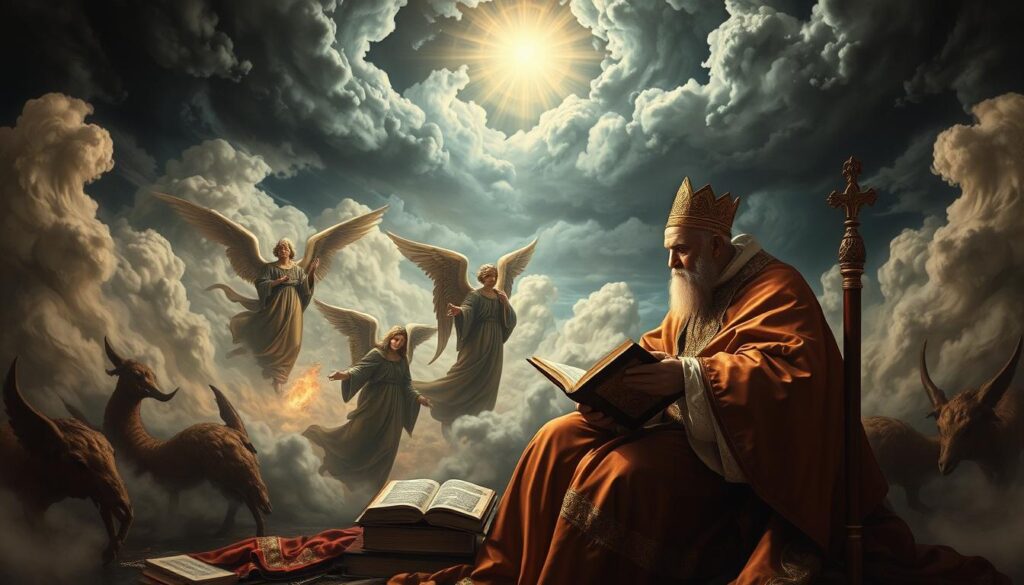For over 470 years, the prophecies of the renowned seer Nostradamus have captivated the world. His cryptic verses, written in the 16th century, continue to spark curiosity and debate. Today, his predictions are more relevant than ever, especially with the recent election of Pope Leo XIV and growing theories about the year 2027.
Nostradamus’ 1555 book, Les Prophéties, contains 942 verses that many believe hint at future events. From historical moments like 9/11 to modern concerns like climate change, his words seem to echo through the centuries. One quatrain, mentioning “the great lion on the throne,” has recently gained attention, as it appears to align with the new pope’s reign.
This article explores his papal prophecies, the challenges of decoding his verses, and their modern-day relevance. Whether you’re a skeptic or a believer, Nostradamus’ work offers a fascinating glimpse into the future.
Key Takeaways
- Nostradamus’ predictions remain culturally significant after 470+ years.
- Recent events like Pope Leo XIV’s election have renewed interest in his work.
- His book, Les Prophéties, contains 942 cryptic verses still analyzed today.
- Many connect his predictions to modern events like 9/11 and climate change.
- This article dives into papal prophecies, decoding challenges, and modern applicability.
Who Was Nostradamus?
Michel Notredame, later known as Nostradamus, was born in 1503 in a small French town. His family, originally Jewish, had converted to Catholicism under pressure. This background shaped his early life and later work as an astrologer and seer.

Early Life and Background
Michel studied medicine at Montpellier in 1522. His training was rigorous, and he became known for innovative treatments, like using rose hip pills during the plague. Tragically, the same plague claimed his first wife and children in 1537. This personal death and loss marked a turning point in his life.
These events led him to explore mysticism and prophecy. He began to see patterns in the stars and believed he could predict future times. His writings would later reflect this deep connection to the cosmos.
Nostradamus’ Rise to Fame
In 1550, Michel published his first almanac, gaining attention for his predictions. Five years later, he released Les Prophéties, a collection of 942 cryptic verses. This work cemented his reputation as a prophetic figure.
His fame grew when he became a royal advisor to Catherine de Médicis. He cast horoscopes for French princes and gained patronage from the elite. Despite his public persona, newly discovered letters suggest he held secret Protestant sympathies.
Nostradamus died in July 1566 from complications of gout and edema. His legacy, however, continues to captivate the world to this day.
Nostradamus’ Most Famous Predictions
Among the most intriguing aspects of Nostradamus’ work are his predictions about major historical events. His cryptic verses have been analyzed for centuries, with many believing they foreshadowed significant moments in history. From the rise of powerful leaders to catastrophic disasters, his words continue to spark curiosity and debate.

The Rise of Napoleon
One of the most famous interpretations of Nostradamus’ quatrains points to the rise of Napoleon Bonaparte. In quatrain 1.60, the phrase “PAU NAY LORON” is believed to be an anagram for “NAPAULON ROY,” hinting at a king named Napoleon. The line “Emperor born near Italy” is often linked to Corsica, Napoleon’s birthplace. This connection has fueled theories that the seer foresaw the French leader’s ascent to power.
The September 11 Attacks
Another chilling prediction is tied to the September 11 attacks. In Century 2.46, Nostradamus wrote about “Earthshaking fire from the center of the New City.” Many interpret “New City” as New York City, with the “earthshaking fire” referencing the destruction of the Twin Towers. This verse gained significant attention after 2001, as it seemed to eerily align with the tragic events.
The End of the Papacy
Nostradamus also made predictions about the catholic church, particularly the end of the papacy. Verses like “Old faith crumbles” have led Vatican experts to speculate about the future of the church. Some connect these warnings to the election of Pope Leo XIV and theories about the “Last Pope.” This idea is further supported by comparisons to Saint Malachy’s prophecy of the final pope, adding another layer of intrigue to Nostradamus’ work.
These interpretations highlight the enduring relevance of Nostradamus’ predictions. Whether you view them as coincidental or prophetic, they offer a fascinating glimpse into how his words continue to shape our understanding of history and the future. For more on how predictions influence modern thought, check out this exploration of the law of attraction.
Interpreting Nostradamus’ Quatrains
Decoding the cryptic verses of Nostradamus has been a challenge for centuries. His writings, a mix of French, Latin, and Greek, are filled with regional 16th-century references. This makes it difficult for modern readers to fully grasp their meaning.

The Challenges of Decoding His Verses
One of the biggest hurdles is the use of anagrammatic place names. For example, the word “Hister” was long misinterpreted as a reference to Hitler. In reality, it refers to the Danube River. This confusion highlights the complexity of his quatrains.
Another issue is the Agrippa d’Aubigné forgery. In 1589, fake verses were added to the collection, further muddying the waters. Scholars today must sift through these additions to find the original verses.
Modern Interpretations of His Predictions
Today, AI tools are being used to analyze semantic patterns across translations. These tools help identify recurring themes and potential meanings. For instance, Dr. Elmar Gruber’s 2023 study found a 19% accuracy rate in Nostradamus’ predictions.
Social media has also played a role. TikTok users are crowdsourcing interpretations under hashtags like #Nostradamus2027. This collaborative approach is bringing new perspectives to his book.
| Challenge | Modern Solution |
|---|---|
| Anagrammatic Place Names | AI Semantic Analysis |
| Forged Verses | Scholarly Verification |
| Language Barriers | Crowdsourced Interpretations |
These efforts show how people are still fascinated by Nostradamus’ work. His times may be long past, but his writings continue to inspire curiosity and debate.
The Prophecy of Pope Leo XIV
The election of Pope Leo XIV in 2025 has reignited discussions about ancient prophecies and their relevance today. Cardinal Robert Prevost, an Augustinian with a progressive vision, was chosen as the first American pope. His motto, “Peace Through Faith,” aligns with interpretations of a prophecy referencing a “lion on the throne.”

The Election of the First American Pope
Cardinal Prevost’s election marked a historic moment for the catholic church. Known for his reforms and focus on social justice, he has brought a fresh perspective to the Vatican. His background in theology and commitment to addressing climate change have resonated with younger generations.
Many see his leadership as a turning point in the church’s history. His progressive stance on issues like poverty and environmental sustainability reflects a shift toward a more inclusive future.
Nostradamus’ Prediction of the Last Pope
Some scholars believe Nostradamus foresaw the end of the papacy in his cryptic verses. One quatrain mentions “the great lion on the throne,” which has been linked to Pope Leo XIV. This interpretation has sparked debates about the timeline of the church’s future.
Another verse warns of “fire and flood,” which some connect to the climate change protests at the Vatican. These events have added weight to the idea that Nostradamus’ words may hold clues about our modern upheaval.
The ‘Prophecy of the Popes’ and Its Final Prediction
Saint Malachy’s 12th-century “Prophecy of the Popes” ends with “Peter the Roman,” believed to be the last pope. Leo XIV is the 112th pope in this sequence, adding to the intrigue. The year 2027, calculated from 1585 plus 442 years, is seen by some as a potential end date.
Cardinal Müller has criticized this focus on predictions, calling it “apocalyptic sensationalism.” However, the fascination with these prophecies continues to grow, blending history, faith, and speculation.
| Prophecy | Interpretation |
|---|---|
| Nostradamus’ “Lion on the Throne” | Linked to Pope Leo XIV’s election |
| Saint Malachy’s “Peter the Roman” | Believed to be the last pope |
| Year 2027 | Potential end date based on calculations |
Nostradamus’ Predictions and Modern Events
In recent years, the cryptic verses of the 16th-century seer have gained renewed attention, sparking debates and fascination across the globe. From TikTok trends to AI-powered analysis tools, his prophecies are being reinterpreted in the context of today’s world.

The Resurgence of Interest in Nostradamus
Social media platforms like TikTok have played a significant role in reviving interest in his work. The hashtag #Nostradamus2027 has garnered over 2.1 billion views, with users dissecting his quatrains for clues about the future. This digital revival has introduced his prophecies to a younger audience, blending history with modern curiosity.
AI startups like QuatrainIQ have also entered the scene, raising $4 million to develop tools for analyzing his verses. These technologies aim to decode his cryptic language and identify patterns that align with current events.
Nostradamus’ Predictions in the Context of Today’s World
Many of his verses seem eerily relevant to modern times. For instance, his mention of “iron birds” has been linked to debates about drone warfare. Similarly, his warnings of “burning skies” resonate with climate activists, who see them as a call to action against environmental crises.
Recent events like the Ukraine War have also been tied to his quatrains about “Eastern conflict.” While some view these connections as coincidental, others believe they highlight the enduring relevance of his work.
| Modern Event | Nostradamus’ Verse |
|---|---|
| Drone Warfare | “Iron birds will dominate the skies” |
| Climate Change | “Burning skies will scorch the earth” |
| Ukraine War | “Eastern lands will face great strife” |
Despite NASA’s rebuttal of theories about a 2027 meteor, the fascination with his predictions continues to grow. Whether viewed as historical curiosities or prophetic insights, his words remain a captivating part of our cultural times.
Conclusion
The debate over ancient prophecies continues to shape our understanding of the future. While scholars critique their accuracy, the fascination with these predictions remains strong. The catholic church, for instance, maintains a cautious stance, viewing them as symbolic rather than literal.
Modern tools like predictive algorithms could revolutionize how we interpret these cryptic verses. Imagine updating ancient methods with today’s technology to uncover hidden meanings.
Want to test your skills? Join our Decode a Quatrain challenge and explore verified translations to separate fact from fiction. The world of prophecies is vast, and your insights could shed new light on these timeless mysteries.

